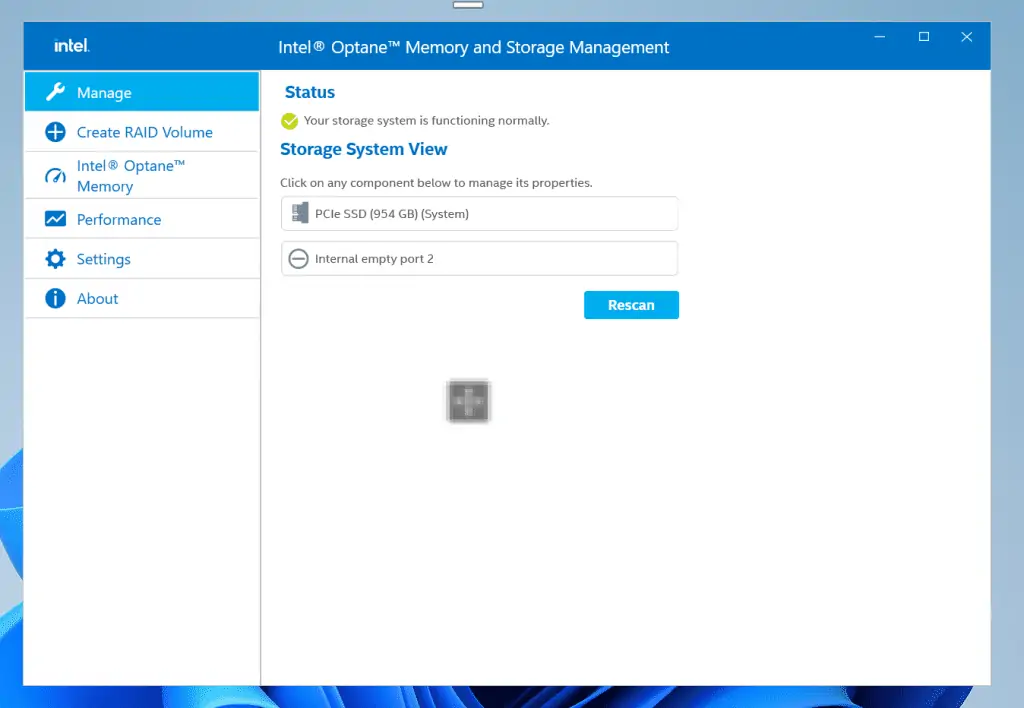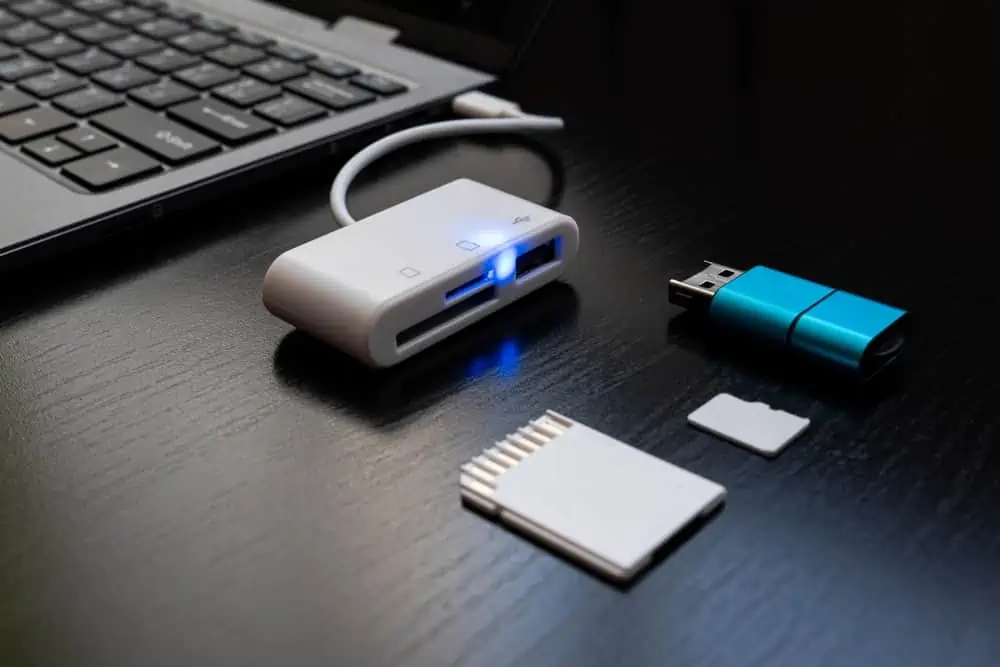Ever heard of Intel rapid storage technology or wondered what it does and how it works? Well, you have come to the right place as this article unravels all the mysteries behind this technology.
On a different note, throughout this article, I could use the full name of this technology or its abbreviation, Intel RST.
Overview
Intel rapid storage technology (Intel RST) is software that enhances the speed and performance of a computer’s SATA storage drives. This technology also increases protection against data loss in an event of storage disk failure or crash.
Moreover, with either one or multiple storage drives, Intel RST reduces power consumption. Speaking of multiple storage drives, this technology can create high-performance storage pools that connect multiple storage drives.
In doing so, it boosts your computer’s speed and data storage capabilities. Therefore, when you perform disk-intensive tasks such as video editing on your computer, you shouldn’t notice any major slowdown or lag.
Additionally, Intel RST offers easy-to-use features and UI for protecting your data. It also rapidly saves and shares data between multiple storage disks on one device.
However, your computer must have a SATA SSD to make use of this technology. Having said all that, let us move to the section below to find out how the Intel rapid storage technology works, shall we?
How Does Intel Rapid Storage Technology Work?
Honestly, there is really nothing much into how Intel rapid storage technology works. First of all, you need to know that Intel RST has two basic requirements – hardware and software.
If your computer uses an Intel processor, it is likely that your computer comes with Intel rapid storage technology software. In addition to the Intel processor hardware requirement – as hinted earlier – your computer needs to feature a SATA SSD.
Alternatively, your computer can have multiple storage drives including a SATA SSD for Intel RST to work.

Hence, the software uses RAID technology (one of its features) to allow users to combine the storage drives into a single logical unit. Therefore, improving the computer’s overall storage capabilities and speed, and preventing data loss.
That’s not all, the software also allows users to configure their storage drives quickly and easily. As a matter of fact, if you create RAID 1, Intel RST will automatically copy data from one storage drive to the other.
In this scenario, in the event of one SATA SSD storage failure, you can recover your data from the second drive. In addition to offering you data recoverability, RAID also boosts performance.
Also, the software tells you when your storage drives need fixing, are almost full, or need defragmentation.
Features Of Intel Rapid Storage Technology
In the previous sections, I have given a quick overview of the Intel rapid storage technology and how it works. In this section, I’ll discuss the features of the technology and how it improves your computer’s performance.
To start with, some of the innovative features of this Intel technology make it ideal for users who want enhanced storage performance and speed. These features include:
Intel Smart Response Technology
This is one of the most important features of Intel rapid storage technology. This features benefits you when there are two or more storage drives on the computer; one of which is a SATA SSD.
Practically, it transfers commonly used data, programs, and files to the SSD and optimizes its speed and performance. Besides, SSDs are typically faster than most storage drives even without Intel RST.
Hence, while your commonly used data/apps are saved on the SATA SSD, it will be very fast for the computer to access them. Thereby, improving the overall performance and speed of your computer.
By the way, by transferring commonly used files to the SATA SSD, this feature also creates more storage space on the other storage drive.
Supports Multiple Commands
Intel RST allows storage disk drives to access more than one command at the same time. However, the commands must use Native Command Queuing before they are able to access them.
In brief, Native Command Queuing (NCQ) is an extension of the Serial ATA (SATA) protocol. It allows storage drives to internally optimize the order in which received read and write commands are carried out.
In case you are wondering, read and write means open and save, storage-wise. Hence, when I say read and write commands, it means your computer giving the storage drive a command to open or save files.
That aside, NCQ can also reduce the number of unnecessary HDD spinning, resulting in increased performance. If you’re curious, unlike SSDs, HDDs have rotating parts that move and make noise during operation.
Hence, thanks to NCQ, unnecessary movements are reduced when the HDD is operating. Thereby, reducing the noise and enhancing the speed at which the HDD responds to read and write commands.
Honestly, by the look of things, this feature benefits HDDs the most, unlike the Intel smart response technology.
Intel RST Supports RAID Technology
RAID (Redundant Array of Independent Disks) is a system in which multiple storage drives work together to improve performance and data protection. Although a few RAID levels (configuration) involve more than two storage drives, they’re typically referred to as RAID arrays.
Moreover, Intel rapid storage technology (Intel RST) supports four RAID levels. These levels include:
RAID 0: This distributes and shares data or files across two storage drives on a computer. Thereby, allowing files, especially large files, to read (open) faster due to the fact that they are on multiple storage drives.
However, RAID 0 has no fault tolerance. What this means is that if one of the storage drives fails or crashes, the RAID will fail and you may lose data.
RAID 1: This copies or mirrors files on two storage drives. As a result, when one storage drive fails, you can recover your files from the second storage drive.
RAID 5: This requires at least three storage drives but can work with up to sixteen storage drives. What it does is distribute files across all the storage drives.
Therefore, if one of the storage drives is faulty or crashes, it allows you to recover the files/data from two or more storage drives.
RAID 10: Also known as RAID 1+0, it combines the ability of RAID 0 and 1 to prevent data loss. Basically, it distributes files as well as mirrors them between multiple storage drives so as to protect them.
However, you will be needing about four or more storage drives to use this RAID level.
Intel Rapid Recover Technology
This feature of Intel RST offers restore/recovery points. With recovery points, users can recover data in an event of data corruption and a storage drive crash.
Basically, it creates a virtual recovery drive and uses the functionality of RAID 1.
By using the RAID 1 functionality, this feature copies data from a designated storage drive to the recovery drive on request or continuously. Hence, thanks to this feature, you don’t have to worry about data loss when using Intel RST.
Dynamic Storage Accelerator
This feature of the Intel RST improves and speeds up the performance of the SATA SSD on your computer. Practically, it dynamically changes the system power management settings of your computer so as to make your SSD faster.
Compared with the default power management settings, the adjusted settings made by this feature can make your SSD about 15% faster.
Pros of Intel Rapid Storage Technology
Enhanced Security
This is one of the major benefits of using Intel RST. The technology automatically protects your computer’s storage drive from unauthorized users by asking for passwords.
Hence, when signing up for this technology, it requires you to set a security password. This protects your storage drive from malware attacks and data loss.
Low Power Consumption
As mentioned earlier, either with single or multiple storage drives on your computer, Intel RST reduces their power consumption.
However, this will benefit laptop users the most as it will increase the battery life of their laptops.
Fast Recovery Speed
While Intel RST prevents data loss, it also offers a fast recovery speed. As a matter of fact, it takes about an hour or two to recover 1 TB of data.
Simple User Interface
Intel RST features an easy-to-use interface that improves functionality and makes navigation easy. This makes managing your storage drives simple and intuitive.
Data Protection
With the help of the RAID feature, Intel RST seamlessly copies data from one storage drive to another in the event of storage drive failure. Therefore, preventing data loss.
Cons of Intel Rapid Storage Technology
Doesn’t Work with HDD Alone
If your computer features only an HDD, you can’t make use of Intel RST. Your computer must have a SATA SSD or multiple storage drives including a SATA SSD to make use of this technology.
Only Works with Intel-powered Computers
Because Intel RST is an Intel technology, it only works in computers with Intel processors. Therefore, if your computer is powered by an AMD processor, you can’t use this technology.
Doesn’t Support PCIe or NVMe SSD
Intel Rapid Storage Technology only supports SATA storage drives. Hence, it cannot work with NVMe or PCIe SSDs.
Automatic Rebuild on Hot-plug May Lead to Data Loss
Intel RST supports the automatic rebuild of degraded RAID volumes when you hot-plug a compatible disk. However, Intel warns that this may lead to data loss.
Frequently Asked Questions
The answer is yes. However, without RAID configured on your computer, you might limit the functionality of Intel RST.
Nonetheless, you can still use the technology to monitor your storage drive’s performance and health. You can also use Intel RST to optimize your computer’s power management.
This technology works when there are multiple storage drives on a computer including a SATA SSD and/or SATA HDD. Furthermore, it is an Intel RST feature that automatically stores frequently used applications and data on a fast-speed SATA SSD.
In doing so, it enhances the computer’s storage performance and gives users access to a large storage space on the SATA HDD.
Definitely. Intel rapid storage technology (Intel RST) is a program that provides enhanced performance and reliability for computers equipped with SATA SSDs.
RAID (Redundant Array of Independent Disks) is a method of storing data on multiple storage drives. This is to protect data in case of storage drive failure.
Absolutely! A core hardware requirement of Intel RST is that the computer must have at least one SATA SSD.
However, Intel RST also supports any additional SATA-enabled storage drives including HDDs and SSHD.
No, it isn’t. You don’t need Intel RST for your SSD to work. In fact, it is the other way around because for the technology to work, your computer needs to have a SATA SSD.
By using the Add/Remove program in your computer’s control panel, you can uninstall Intel Rapid Storage Technology from your computer. Go to your computer’s control panel and select “uninstall a program” or “add or remove programs”.
After that, locate the Intel RST software, click on it, and select uninstall.
Lots of people have asked whether or not it’s possible to delete Intel Rapid Storage Technology. This may be because they aren’t planning to use it or their computer doesn’t have a SATA solid-state drive (SSD).
Well, the answer is a resounding YES. In fact, Intel encourages users to uninstall the program if they aren’t planning to use it.
While about fifty percent of Intel rapid storage technology users come from the United States, this technology is also popular in the UK and Germany.
Even though this technology needs a SATA SSD to operate, it still works with HDD. That’s if your computer has both a SATA SSD and HDD.
Conclusion
Intel rapid storage technology (Intel RST) is an innovative technology that not only improves storage performance but also prevents data loss. With this technology, you should worry less about losing your data in an event of storage disk failure.
However, because this technology was created by Intel, it doesn’t work with computers powered by an AMD processor. Also, it only supports SATA storage drives and your computer must include a SATA SSD before it works.
Nonetheless, Intel RST is a fantastic technology that will save you time and money if you experience storage disk failure. Also, since the technology improves the performance of SATA storage drives, users can seamlessly perform disk-intensive workloads on their computers.
Besides, it is an outstanding feature for users with multiple storage drives that require optimal storage performance.
I hope that I have been able to cover all the important information about Intel rapid storage technology. I also hope you found this article simple and easy to comprehend or understand.
If you did, click on “Yes” beside the “Was this page helpful” question below. You may also express your thoughts and opinions by using the “Leave a Comment” form at the bottom of this page.
Finally, you may find other helpful articles on our Storage & Disk Technology Explained page.



